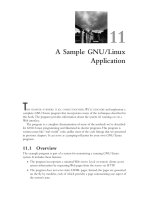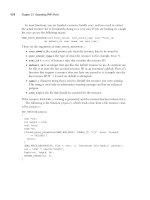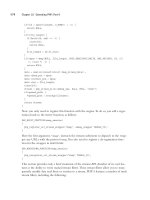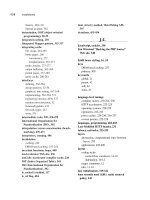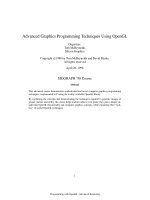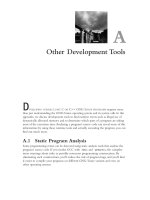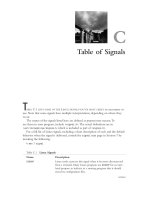Advanced PHP Programming- P13
Bạn đang xem bản rút gọn của tài liệu. Xem và tải ngay bản đầy đủ của tài liệu tại đây (488.38 KB, 50 trang )
578
Chapter 22 Extending PHP: Part II
if((fd = open(filename, O_RDWR)) < -1) {
return NULL;
}
if(!file_length) {
if(fstat(fd, &sb) == -1) {
close(fd);
return NULL;
}
file_length = sb.st_size;
}
if((mpos = mmap(NULL, file_length, PROT_READ|PROT_WRITE, MAP_PRIVATE, fd, 0))
== (void *) -1) {
return NULL;
}
data = emalloc(sizeof(struct mmap_stream_data));
data->base_pos = mpos;
data->current_pos = mpos;
data->len = file_length;
close(fd);
stream = php_stream_alloc(&mmap_ops, data, NULL,
“
mode
”
);
if(opened_path) {
*opened_path = estrdup(filename);
}
return stream;
}
Now you only need to register this function with the engine.To do so, you add a regis-
tration hook to the
MINIT
function, as follows:
PHP_MINIT_FUNCTION(mmap_session)
{
php_register_url_stream_wrapper(
“
mmap
”
, &mmap_wrapper TSRMLS_CC);
}
Here the first argument,
“
mmap
”
, instructs the streams subsystem to dispatch to the wrap-
per any URLs with the protocol
mmap
.You also need to register a de-registration func-
tion for the wrapper in
MSHUTDOWN
:
PHP_MSHUTDOWN_FUNCTION(mmap_session)
{
php_unregister_url_stream_wrapper(
“
mmap
”
TSRMLS_CC);
}
This section provides only a brief treatment of the streams API. Another of its cool fea-
tures is the ability to write stacked stream filters.These stream filters allow you to trans-
parently modify data read from or written to a stream. PHP 5 features a number of stock
stream filters, including the following:
Please purchase PDF Split-Merge on www.verypdf.com to remove this watermark.
579
Further Reading
n
Content compression
n
HTTP 1.1 chunked encoding/decoding
n
Streaming cryptographic ciphers via
mcrypt
n
Whitespace folding
The streams API’s ability to allow you to transparently affect all the internal I/O func-
tions in PHP is extremely powerful. It is only beginning to be fully explored, but I
expect some very ingenious uses of its capabilities over the coming years.
Further Reading
The official PHP documentation of how to author classes and streams is pretty sparse. As
the saying goes,“Use the force, read the source.”That having been said, there are some
resources out there. For OOP extension code, the following are some good resources:
n
The Zend Engine2 Reflection API, in the PHP source tree under
Zend/
reflection_api.c
, is a good reference for writing classes in C.
n
The streams API is documented in the online PHP manual at
/>. In addition,Wez Furlong, the
streams API architect, has an excellent talk on the subject, which is available at
/>.
Please purchase PDF Split-Merge on www.verypdf.com to remove this watermark.
Please purchase PDF Split-Merge on www.verypdf.com to remove this watermark.
23
Writing SAPIs and Extending the
Zend Engine
T
HE FLIP SIDE TO WRITING
PHP
EXTENSIONS
in C is writing applications in C that run
PHP.There are a number of reasons you might want to do this:
n
To allow PHP to efficiently operate on a new Web server platform.
n
To harness the ease of use of a scripting language inside an application. PHP pro-
vides powerful templating capabilities that can be validly embedded in many appli-
cations. An example of this is the PHP filter SAPI, which provides a PHP interface
for writing
sendmail
mail filters in PHP.
n
For easy extensibility.You can allow end users to customize parts of an application
with code written in PHP.
Understanding how PHP embeds into applications is also important because it helps you
get the most out of the existing SAPI implementations. Do you like
mod_php
but feel
like it’s missing a feature? Understanding how SAPIs work can help you solve your
problems. Do you like PHP but wish the Zend Engine had some additional features?
Understanding how to modify its behavior can help you solve your problems.
SAPIs
SAPIs provide the glue for interfacing PHP into an application.They define the ways in
which data is passed between an application and PHP.
The following sections provide an in-depth look at a moderately simple SAPI, the
PHP CGI SAPI, and the embed SAPI, for embedding PHP into an application with
minimal custom needs.
Please purchase PDF Split-Merge on www.verypdf.com to remove this watermark.
582
Chapter 23 Writing SAPIs and Extending the Zend Engine
The CGI SAPI
The CGI SAPI provides a good introduction to how SAPIs are implemented. It is sim-
ple, in that it does not have to link against complicated external entities as
mod_php
does.
Despite this relative simplicity, it supports reading in complex environment information,
including
POST
,
GET
, and cookie data.This import of environmental information is one
of the major duties of any SAPI implementation, so it is important to understand it.
The defining structure in a SAPI is
sapi_module_struct
, which defines all the ways
that the SAPI can bridge PHP and the environment so that it can set environment and
query variables.
sapi_module_struct
is a collection of details and function pointers that
tell the SAPI how to hand data to and from PHP. It is defined as follows:
struct _sapi_module_struct {
char *name;
char *pretty_name;
int (*startup)(struct _sapi_module_struct *sapi_module);
int (*shutdown)(struct _sapi_module_struct *sapi_module);
int (*activate)(TSRMLS_D);
int (*deactivate)(TSRMLS_D);
int (*ub_write)(const char *str, unsigned int str_length TSRMLS_DC);
void (*flush)(void *server_context);
struct stat *(*get_stat)(TSRMLS_D);
char *(*getenv)(char *name, size_t name_len TSRMLS_DC);
void (*sapi_error)(int type, const char *error_msg, ...);
int (*header_handler)(sapi_header_struct *sapi_header,
sapi_headers_struct *sapi_headers TSRMLS_DC);
int (*send_headers)(sapi_headers_struct *sapi_headers TSRMLS_DC);
void (*send_header)(sapi_header_struct *sapi_header,
void *server_context TSRMLS_DC);
int (*read_post)(char *buffer, uint count_bytes TSRMLS_DC);
char *(*read_cookies)(TSRMLS_D);
void (*register_server_variables)(zval *track_vars_array TSRMLS_DC);
void (*log_message)(char *message);
char *php_ini_path_override;
void (*block_interruptions)(void);
void (*unblock_interruptions)(void);
void (*default_post_reader)(TSRMLS_D);
void (*treat_data)(int arg, char *str, zval *destArray TSRMLS_DC);
char *executable_location;
int php_ini_ignore;
int (*get_fd)(int *fd TSRMLS_DC);
int (*force_http_10)(TSRMLS_D);
int (*get_target_uid)(uid_t * TSRMLS_DC);
int (*get_target_gid)(gid_t * TSRMLS_DC);
unsigned int (*input_filter)(int arg, char *var, char **val,
unsigned int val_len TSRMLS_DC);
Please purchase PDF Split-Merge on www.verypdf.com to remove this watermark.
583
SAPIs
void (*ini_defaults)(HashTable *configuration_hash);
int phpinfo_as_text;
};
Here is the module structure for the CGI SAPI:
static sapi_module_struct cgi_sapi_module = {
“
cgi
”
, /* name */
“
CGI
”
, /* pretty name */
php_cgi_startup, /* startup */
php_module_shutdown_wrapper, /* shutdown */
NULL, /* activate */
sapi_cgi_deactivate, /* deactivate */
sapi_cgibin_ub_write, /* unbuffered write */
sapi_cgibin_flush, /* flush */
NULL, /* get uid */
sapi_cgibin_getenv, /* getenv */
php_error, /* error handler */
NULL, /* header handler */
sapi_cgi_send_headers, /* send headers handler */
NULL, /* send header handler *=
sapi_cgi_read_post, /* read POST data */
sapi_cgi_read_cookies, /* read Cookies */
sapi_cgi_register_variables, /* register server variables */
sapi_cgi_log_message, /* Log message */
STANDARD_SAPI_MODULE_PROPERTIES
};
Notice that the last 14 fields of the struct have been replaced with the macro
STANDARD_
SAPI_PROPERTIES
.This common technique used by SAPI authors takes advantage of the
C language semantic of defining omitted struct elements in a declaration as
NULL
.
The first two fields in the struct are the name of the SAPI.These are what is returned
when you call
phpinfo()
or
php_sapi_name()
from a script.
The third field is the function pointer
sapi_module_struct.startup
.When an
application implementing a PHP SAPI is started, this function is called. An important
task for this function is to bootstrap the rest of the loading by calling
php_module_startup()
on its module details. In the CGI module, only the bootstrap-
ping procedure is performed, as shown here:
static int php_cgi_startup(sapi_module_struct *sapi_module)
{
if (php_module_startup(sapi_module, NULL, 0) == FAILURE) {
return FAILURE;
}
return SUCCESS;
}
Please purchase PDF Split-Merge on www.verypdf.com to remove this watermark.
584
Chapter 23 Writing SAPIs and Extending the Zend Engine
The fourth element,
sapi_module_struct.shutdown
, is the corresponding function
called when the SAPI is shut down (usually when the application is terminating).The
CGI SAPI (like most of the SAPIs that ship with PHP) calls
php_module_shutdown_wrapper
as its shutdown function.This simply calls
php_mod-
ule_shutdown
, as shown here:
int php_module_shutdown_wrapper(sapi_module_struct *sapi_globals)
{
TSRMLS_FETCH();
php_module_shutdown(TSRMLS_C);
return SUCCESS;
}
As described in Chapter 20, “PHP and Zend Engine Internals,” on every request, the
SAPI performs startup and shutdown calls to clean up its running environment and to
reset any resources it may require.These are the fifth and sixth
sapi_module_struct
elements.The CGI SAPI does not define
sapi_module_struct.activate
, meaning that
it registers no generic request-startup code, but it does register
sapi_module_struct.deactivate
.In
deactivate
, the CGI SAPI flushes its output file
streams to guarantee that the end user gets all the data before the SAPI closes its end of
the socket.The following are the deactivation code and the flush helper function:
static void sapi_cgibin_flush(void *server_context)
{
if (fflush(stdout)==EOF) {
php_handle_aborted_connection();
}
}
static int sapi_cgi_deactivate(TSRMLS_D)
{cdx
sapi_cgibin_flush(SG(server_context));
return SUCCESS;
}
Note that
stdout
is explicitly flushed; this is because the CGI SAPI is hard-coded to
send output to
stdout
.
A SAPI that implements more complex
activate
and
deactivate
functions is the
Apache module
mod_php
. Its
activate
function registers memory cleanup functions in
case Apache terminates the script prematurely (for instance, if the client clicks the Stop
button in the browser or the script exceeds Apache’s timeout setting).
The seventh element,
sapi_module_struct.ub_write
, provides a callback for how
PHP should write data to the user when output buffering is not on.This is the function
that will actually send the data when you use
or
echo
on something in a PHP
script. As mentioned earlier, the CGI SAPI writes directly to
stdout
. Here is its imple-
mentation, which writes data in 16KB chunks:
Please purchase PDF Split-Merge on www.verypdf.com to remove this watermark.
585
SAPIs
static inline size_t sapi_cgibin_single_write(const char *str,
uint str_length TSRMLS_DC)
{
size_t ret;
ret = fwrite(str, 1, MIN(str_length, 16384), stdout);
return ret;
}
static int sapi_cgibin_ub_write(const char *str, uint str_length TSRMLS_DC)
{
const char *ptr = str;
uint remaining = str_length;
size_t ret;
while (remaining > 0) {
ret = sapi_cgibin_single_write(ptr, remaining TSRMLS_CC);
if (!ret) {
php_handle_aborted_connection();
return str_length - remaining;
}
ptr += ret;
remaining -= ret;
}
return str_length;
}
This method writes each individual character separately, which is inefficient but very
cross-platform portable. On systems that support POSIX input/output, you could as eas-
ily consolidate this function into the following:
static int sapi_cgibin_ub_write(const char *str, uint str_length TSRMLS_DC)
{
size_t ret;
ret = write(fileno(stdout), str, str_length);
return (ret >= 0)?ret:0;
}
The eighth element is
sapi_module_struct.flush
, which gives PHP a way to flush its
stream buffers (for example, when you call
flush()
within a PHP script).This uses the
function
sapi_cgibin_flush
, which you saw called earlier from within the
deactivate
function.
The ninth element is
sapi_module_struct.get_stat
.This provides a callback to
override the default
stat()
of the file performed to ensure that the script can be run in
safe mode.The CGI SAPI does not implement this hook.
The tenth element is
sapi_module_struct.getenv
.
getenv
provides an interface to
look up environment variables by name. Because the CGI SAPI runs akin to a regular
Please purchase PDF Split-Merge on www.verypdf.com to remove this watermark.
586
Chapter 23 Writing SAPIs and Extending the Zend Engine
user shell script, its
sapi_cgibin_getenv()
function is just a simple gateway to the C
function
getenv()
, as shown here:
static char *sapi_cgibin_getenv(char *name, size_t name_len TSRMLS_DC)
{
return getenv(name);
}
In more complex applications, such as
mod_php
, the SAPI should implement
sapi_
module_struct.getenv
on top of the application’s internal environment facilities.
The eleventh element is the callback
sapi_module_struct.sapi_error
.This sets the
function to be called whenever a userspace error or an internal call to
zend_error()
occurs. Most SAPIs set this to
php_error
, which is the built-in PHP error handler.
The twelfth element is
sapi_module_struct.header_handler
.This function is
called anytime you call
header()
inside code or when PHP sets its own internal head-
ers.The CGI SAPI does not set its own
header_handler
, which means that it falls back
on the default SAPI behavior, which is to append it to an internal list that PHP man-
ages.This callback is mainly used in Web server SAPIs such as
mod_php
, where the Web
server wants to maintain the headers itself instead of having PHP do so.
The thirteenth element is
sapi_module_struct.send_headers
.This is called when it
is time to send all the headers that have been set in PHP (that is, immediately before the
first content is sent).This callback can choose to send all the headers itself, in which case
it returns
SAPI_HEADER_SENT_SUCCESSFULLY
, or it can delegate the task of sending indi-
vidual headers to the fourteenth
sapi_module_struct
element,
send_header
, in which
case it should return
SAPI_HEADER_DO_SEND
.The CGI SAPI chooses the first methodol-
ogy and writes all its headers in a
send_headers
function, defined as follows:
static int sapi_cgi_send_headers(sapi_headers_struct *sapi_headers TSRMLS_DC)
{
char buf[SAPI_CGI_MAX_HEADER_LENGTH];
sapi_header_struct *h;
zend_llist_position pos;
long rfc2616_headers = 0;
if(SG(request_info).no_headers == 1) {
return SAPI_HEADER_SENT_SUCCESSFULLY;
}
if (SG(sapi_headers).http_response_code != 200) {
int len;
len = sprintf(buf,
“
Status: %d\r\n
”
, SG(sapi_headers).http_response_code);
PHPWRITE_H(buf, len);
}
if (SG(sapi_headers).send_default_content_type) {
char *hd;
hd = sapi_get_default_content_type(TSRMLS_C);
Please purchase PDF Split-Merge on www.verypdf.com to remove this watermark.
587
SAPIs
PHPWRITE_H(
“
Content-type:
“
, sizeof(
“
Content-type:
“
)-1);
PHPWRITE_H(hd, strlen(hd));
PHPWRITE_H(
“
\r\n
”
, 2);
efree(hd);
}
h = zend_llist_get_first_ex(&sapi_headers->headers, &pos);
while (h) {
PHPWRITE_H(h->header, h->header_len);
PHPWRITE_H(
“
\r\n
”
, 2);
h = zend_llist_get_next_ex(&sapi_headers->headers, &pos);
}
PHPWRITE_H(
“
\r\n
”
, 2);
return SAPI_HEADER_SENT_SUCCESSFULLY;
}
PHPWRITE_H
is a macro wrapper that handles output buffering, which might potentially
be on.
The fifteenth element is
sapi_module_struct.read_post
, which specifies how
POST
data should be read.The function is passed a buffer and a buffer size, and it is expected
to fill out the buffer and return the length of the data within. Here is the CGI SAPI’s
implementation, which simply reads up to the specified buffer size of data from
stdin
(file descriptor 0):
static int sapi_cgi_read_post(char *buffer, uint count_bytes TSRMLS_DC)
{
uint read_bytes=0, tmp_read_bytes;
count_bytes = MIN(count_bytes,
(uint)SG(request_info).content_length-SG(read_post_bytes));
while (read_bytes < count_bytes) {
tmp_read_bytes = read(0, buffer+read_bytes, count_bytes-read_bytes);
if (tmp_read_bytes<=0) {
break;
}
read_bytes += tmp_read_bytes;
}
return read_bytes;
}
Note that no parsing is done here:
read_post
only provides the facility to read in raw
post data. If you want to modify the way PHP parses
POST
data, you can do so in
sapi_module_struct.default_post_reader
, which is covered later in this chapter, in
the section “SAPI Input Filters.”
The sixteenth element is
sapi_module_struct.read_cookies
.This performs the
same function as
read_post
, except on cookie data. In the CGI specification, cookie
data is passed in as an environment variable, so the CGI SAPI cookie reader just uses the
Please purchase PDF Split-Merge on www.verypdf.com to remove this watermark.
588
Chapter 23 Writing SAPIs and Extending the Zend Engine
getenv
callback to extract it, as shown here:
static char *sapi_cgi_read_cookies(TSRMLS_D)
{
return sapi_cgibin_getenv((char *)
”
HTTP_COOKIE
”
,0 TSRMLS_CC);
}
Again, filtering this data is covered in the section “SAPI Input Filters.”
Next comes
sapi_module_struct.register_server_variables
. As the name
implies, this function is passed in what will become the
$_SERVER
autoglobal array, and
the SAPI has the option of adding elements to the array.The following is the top-level
register_server_variables
callback for the CGI SAPI:
static void sapi_cgi_register_variables(zval *track_vars_array TSRMLS_DC)
{
php_import_environment_variables(track_vars_array TSRMLS_CC);
php_register_variable(
“
PHP_SELF
”
,
(SG(request_info).request_uri ? SG(request_info).request_uri:
””
),
track_vars_array TSRMLS_CC);
}
This calls
php_import_environment_variables()
, which loops through all the shell
environment variables and creates entries for them in
$_SERVER
.Then it sets
$_SERVER[
‘
PHP_SELF
’
]
to be the requested script.
The last declared element in the CGI module is
sapi_module_struct.log_message
.
This is a fallback function when no other error logging facility is specified. If
error_log
is not set in the
php.ini
file, then this is the function that will be called to print out any
errors you receive.The CGI module implements this by printing to
stderr
, as follows:
static void sapi_cgi_log_message(char *message)
{
fprintf(stderr,
“
%s\n
”
, message);
}
We’ve now covered the standard
sapi_module_struct
elements.The filtering callbacks
default_post_reader
,
treat_data
,and
input_filter
are covered later in this chapter,
in the section “SAPI Input Filters.”The others are special-purpose elements that are not
covered here.
The CGI SAPI Application
You need to incorporate the CGI SAPI into an application that can actually run it.The
actual CGI
main()
routine is very long, as it supports a wide variety of options and
flags. Instead of covering that (which could easily take an entire chapter), this section
provides a very stripped-down version of the
main()
routine that implements no
optional flags. Here is the stripped-down version of the CGI
main()
routine:
int main(int argc, char **argv)
{
Please purchase PDF Split-Merge on www.verypdf.com to remove this watermark.
589
SAPIs
int exit_status = SUCCESS;
zend_file_handle file_handle;
int retval = FAILURE;
signal(SIGPIPE, SIG_IGN); /* ignore disconnecting clients */
sapi_startup(&cgi_sapi_module);
cgi_sapi_module.executable_location = argv[0];
if (php_module_startup(&cgi_sapi_module, NULL, 0) == FAILURE) {
return FAILURE;
}
zend_first_try {
SG(server_context) = (void *) 1; /* avoid server_context==NULL checks */
init_request_info(TSRMLS_C);
file_handle.type = ZEND_HANDLE_FILENAME;
file_handle.filename = SG(request_info).path_translated;
file_handle.handle.fp = NULL;
file_handle.opened_path = NULL;
file_handle.free_filename = 0;
if (php_request_startup(TSRMLS_C)==FAILURE) {
php_module_shutdown(TSRMLS_C);
return FAILURE;
}
retval = php_fopen_primary_script(&file_handle TSRMLS_CC);
if (retval == FAILURE && file_handle.handle.fp == NULL) {
SG(sapi_headers).http_response_code = 404;
PUTS(
“
No input file specified.\n
”
);
php_request_shutdown((void *) 0);
php_module_shutdown(TSRMLS_C);
return FAILURE;
}
php_execute_script(&file_handle TSRMLS_CC);
if (SG(request_info).path_translated) {
char *path_translated;
path_translated = strdup(SG(request_info).path_translated);
efree(SG(request_info).path_translated);
SG(request_info).path_translated = path_translated;
}
php_request_shutdown((void *) 0);
if (exit_status == 0) {
exit_status = EG(exit_status);
}
if (SG(request_info).path_translated) {
free(SG(request_info).path_translated);
SG(request_info).path_translated = NULL;
Please purchase PDF Split-Merge on www.verypdf.com to remove this watermark.
590
Chapter 23 Writing SAPIs and Extending the Zend Engine
}
} zend_catch {
exit_status = 255;
} zend_end_try();
php_module_shutdown(TSRMLS_C);
sapi_shutdown();
return exit_status;
}
The following is the helper function
init_request_info()
, which sets the SAPI globals
for script locations and query string parameters from the environment as per the CGI
specification:
static void init_request_info(TSRMLS_D)
{
char *env_script_filename = sapi_cgibin_getenv(
“
SCRIPT_FILENAME
”
,0 TSRMLS_CC);
char *env_path_translated = sapi_cgibin_getenv(
“
PATH_TRANSLATED
”
,0 TSRMLS_CC);
char *script_path_translated = env_script_filename;
/* initialize the defaults */
SG(request_info).path_translated = NULL;
SG(request_info).request_method = NULL;
SG(request_info).query_string = NULL;
SG(request_info).request_uri = NULL;
SG(request_info).content_type = NULL;
SG(request_info).content_length = 0;
SG(sapi_headers).http_response_code = 200;
/* script_path_translated being set is a good indication that
we are running in a cgi environment, since it is always
null otherwise. otherwise, the filename
of the script will be retrieved later via argc/argv */
if (script_path_translated) {
const char *auth;
char *content_length = sapi_cgibin_getenv(
“
CONTENT_LENGTH
”
,0 TSRMLS_CC);
char *content_type = sapi_cgibin_getenv(
“
CONTENT_TYPE
”
,0 TSRMLS_CC);
SG(request_info).request_method =
sapi_cgibin_getenv(
“
REQUEST_METHOD
”
,0 TSRMLS_CC);
SG(request_info).query_string =
sapi_cgibin_getenv(
“
QUERY_STRING
”
,0 TSRMLS_CC);
if (script_path_translated && !strstr(script_path_translated,
“
..
”
)) {
SG(request_info).path_translated = estrdup(script_path_translated);
}
SG(request_info).content_type = (content_type ? content_type :
“”
);
SG(request_info).content_length = (content_length?atoi(content_length):0);
Please purchase PDF Split-Merge on www.verypdf.com to remove this watermark.
591
SAPIs
/* The CGI RFC allows servers to pass on unvalidated Authorization data */
auth = sapi_cgibin_getenv(
“
HTTP_AUTHORIZATION
”
,0 TSRMLS_CC);
php_handle_auth_data(auth TSRMLS_CC);
}
}
The following is the basic execution order of this script:
1. Call
sapi_startup(&cgi_sapi_module)
.This sets up all the default SAPI struc-
tures.
2. Call
php_module_startup(&cgi_sapi_module, NULL, 0)
.This actually loads,
initializes, and registers this SAPI.
3. Call
init_request_info()
.This function sets the necessary SAPI global’s
request_info
values from the environment.This is how the CGI SAPI knows
what file you want to execute and what parameters are being passed to it. Every
SAPI implements this differently. For example,
mod_php
extracts all this informa-
tion from the Apache
request_rec
data structure.
4. Initialize
zend_file_handle
with the location of the script to execute.
5. Call
php_request_startup()
.This function does a large amount of work: It ini-
tializes the output buffering system for the request, creates all autoglobal variables,
calls the
RINIT
hooks of all registered extensions, and calls the
activate
callback
for the SAPI.
6. Open and execute the script with
php_fopen_primary_script(&file_handle
TSRMLS_CC)
and
php_execute_script(&file_handle TSRMLS_CC)
.Technically, it
is not necessary to open the script, but doing so allows an easy way to check
whether the script actually exists.When
php_execute_script()
returns, the script
has completed.
7. Call
php_request_shutdown((void *) 0)
to complete the request.This calls the
RSHUTDOWN
hooks for modules, calls the
deactivate
callback registered by the
SAPI, and ends output buffering and sends all data to the client.
8. Call
php_module_shutdown
.This shuts down the SAPI permanently because the
CGI SAPI serves only a single request per invocation.
9. Call
sapi_shutdown()
.This performs final cleanup of the SAPI environment.
This is the complete process of embedding the PHP interpreter into an application,
using the SAPI interface.
The Embed SAPI
The CGI SAPI seems like quite a bit of work, but the majority of it involves handling
automatic importing of data from the caller’s environment. PHP goes to great trouble to
Please purchase PDF Split-Merge on www.verypdf.com to remove this watermark.
592
Chapter 23 Writing SAPIs and Extending the Zend Engine
allow transparent access to user environment data, and much of that work has to be done
in the SAPI implementation.
If your goals are less ambitious than full custom PHP integration and you only want
to execute PHP code as part of an application, the embed SAPI may be the right solu-
tion for you.The embed SAPI exposes PHP as a shared library that you can link against
and run code.
To build the embed library, you need to compile PHP with the following configura-
tion line:
--enable-embed
This creates
libphp5.so
.
The embed SAPI exposes two macros to the user:
PHP_EMBED_START_BLOCK(int argc, char **argv)
PHP_EMBED_END_BLOCK()
Inside the block defined by those macros is a running PHP environment where you can
execute scripts with this:
php_execute_script(zend_file_handle *primary_file TSRMLS_DC);
or this:
zend_eval_string(char *str, zval *retval_ptr,
char *string_name TSRMLS_DC);
As an example of just how simple this is, here is a working PHP shell that interactively
executes anything you pass to it:
#include <php_embed.h>
#include <stdio.h>
#include <readline/readline.h>
#include <readline/history.h>
int main(int argc, char **argv) {
char *code;
PHP_EMBED_START_BLOCK(argc,argv);
while((code = readline(
“
>
“
)) != NULL) {
zend_eval_string(code, NULL, argv[0] TSRMLS_CC);
}
PHP_EMBED_END_BLOCK();
return 0;
}
You then compile this, as shown here:
> gcc -pipe -g -O2 -I/usr/local/include/php -I/usr/local/include/php/Zend \
-I/usr/local/include/php/TSRM -I/usr/local/include/php/main -c psh.c
> gcc -pipe -g -O2 -L/usr/local/lib -lreadline -lncurses -lphp5 psh.o -o psh
Please purchase PDF Split-Merge on www.verypdf.com to remove this watermark.
593
SAPIs
Note that the embed SAPI sets the
$argc
and
$argv
autoglobals from what is passed to
PHP_EMBED_START_BLOCK()
. Check out the following
psh
session:
> ./psh foo bar
> print_r($argv);
Array
(
[0] => ./psh
[1] => foo
[2] => bar
)
> $a = 1;
“
$a\n
”
;
1
>
This is a toy example in that
psh
is pretty featureless, but it demonstrates how you can
leverage all of PHP in under 15 lines of C. Later in this chapter you will use the embed
SAPI to build a more significant application: the opcode dumper described in Chapter
20.
SAPI Input Filters
In Chapter 13,“User Authentication and Session Security,” you learned a bit about cross-
site scripting and SQL injection attacks. Although they manifest differently, both attacks
involve getting a Web application to accidentally execute (or in the case of cross-site
scripting, getting a third-party user to execute) malicious code in your application’s
space.
The solution to all attacks of this sort is simple:You must be fanatical about validating
and sanitizing any input a user gives you.The responsibility for this sanitization process
lies with the developer, but leaving it at that can be unsatisfactory for two reasons:
n
Developers sometimes make mistakes. Cross-site scripting is an extremely serious
security issue, and relying on everyone who touches PHP code to always perform
the correct security measures may not be good enough.
n
Sanitizing all your data in PHP on every request can be slow.
To help address this issue, the SAPI interface provides a set of three callbacks that can be
used to automatically sanitize data on every incoming request:
input_filter
,
treat_data
,and
default_post_reader
. Because they are registered at the SAPI level,
they are invisible to the developer and are executed automatically.This makes it impossi-
ble to forget to apply them on a page. Further, because they are implemented in C and
occur before data is inserted into the autoglobal arrays, the implementations can be
much faster than anything written in PHP.
Please purchase PDF Split-Merge on www.verypdf.com to remove this watermark.
594
Chapter 23 Writing SAPIs and Extending the Zend Engine
input_filter
The most useful of the filter callbacks is
sapi_module_struct.input_filter
.A regis-
tered
input_filter
callback is called on the input to be populated into the auto-globals
$_POST
,
$_GET
,and
$_COOKIE
before the input data is actually inserted into the arrays.
An
input_filter
callback provides a blanket mechanism for sanitizing all user-
submitted data before it is available to userspace code.
This section describes an
input_filter
that removes all HTML from
POST
,
GET
,and
COOKIE
data using the C code from the
strip_tags()
PHP function.This is a variation
of the
input_filter
example in the PHP distribution, with a few extra bells and whis-
tles. A new set of autoglobal arrays—
$_RAW_POST
,
$_RAW_GET
,and
$_RAW_COOOKIE
—is
created, and the original contents of each variable are placed in that new array, with the
cleaned data going into the standard arrays.That way, if a developer needs access to the
original source, he or she can still have access to it, but the standard arrays will be free of
HTML.
Input filters of all kinds can be registered post-SAPI startup, and this one is imple-
mented as an extension.This is nice because it means you do not have to actually modify
the code of the SAPI you use.
First is the standard module header.You add a global
zval *
for each of the new
autoglobal arrays you are creating. Here is the code for this:
#ifdef HAVE_CONFIG_H
# include
“
config.h
”
#endif
#include
“
php.h
”
#include
“
php_globals.h
”
#include
“
php_variables.h
”
#include
“
ext/standard/info.h
”
#include
“
ext/standard/php_string.h
”
ZEND_BEGIN_MODULE_GLOBALS(raw_filter)
zval *post_array;
zval *get_array;
zval *cookie_array;
ZEND_END_MODULE_GLOBALS(raw_filter)
#ifdef ZTS
#define IF_G(v) TSRMG(raw_filter_globals_id, zend_raw_filter_globals *, v)
#else
#define IF_G(v) (raw_filter_globals.v)
#endif
ZEND_DECLARE_MODULE_GLOBALS(raw_filter)
Please purchase PDF Split-Merge on www.verypdf.com to remove this watermark.
595
SAPIs
unsigned int raw_filter(int arg, char *var, char **val, unsigned int val_len,
unsigned int *new_val_len TSRMLS_DC)
static void php_raw_filter_init_globals(zend_raw_filter_globals *globals)
{
memset(globals, 0, sizeof(zend_raw_filter_globals *));
}
PHP_MINIT_FUNCTION(raw_filter)
{
ZEND_INIT_MODULE_GLOBALS(raw_filter, php_raw_filter_init_globals, NULL);
zend_register_auto_global(
“
_RAW_GET
”
, sizeof(
“
_RAW_GET
”
)-1, NULL TSRMLS_CC);
zend_register_auto_global(
“
_RAW_POST
”
, sizeof(
“
_RAW_POST
”
)-1, NULL TSRMLS_CC);
zend_register_auto_global(
“
_RAW_COOKIE
”
, sizeof(
“
_RAW_COOKIE
”
)-1,
NULL TSRMLS_CC);
sapi_register_input_filter(raw_filter);
return SUCCESS;
}
PHP_MSHUTDOWN_FUNCTION(raw_filter)
{
return SUCCESS;
}
PHP_RSHUTDOWN_FUNCTION(raw_filter)
{
if(IF_G(get_array)) {
zval_ptr_dtor(&IF_G(get_array));
IF_G(get_array) = NULL;
}
if(IF_G(post_array)) {
zval_ptr_dtor(&IF_G(post_array));
IF_G(post_array) = NULL;
}
if(IF_G(cookie_array)) {
zval_ptr_dtor(&IF_G(cookie_array));
IF_G(cookie_array) = NULL;
}
return SUCCESS;
}
PHP_MINFO_FUNCTION(raw_filter)
{
php_info_print_table_start();
php_info_print_table_row( 2,
“
strip_tags() Filter Support
”
,
“
enabled
”
);
php_info_print_table_end();
Please purchase PDF Split-Merge on www.verypdf.com to remove this watermark.
596
Chapter 23 Writing SAPIs and Extending the Zend Engine
}
zend_module_entry raw_filter_module_entry = {
STANDARD_MODULE_HEADER,
“
raw_filter
”
,
NULL,
PHP_MINIT(raw_filter),
PHP_MSHUTDOWN(raw_filter),
NULL,
PHP_RSHUTDOWN(raw_filter),
PHP_MINFO(raw_filter),
“
0.1
”
,
STANDARD_MODULE_PROPERTIES
};
#ifdef COMPILE_DL_RAW_FILTER
ZEND_GET_MODULE(raw_filter);
#endif
This is largely a standard module.There are two new things to notice, though.The first is
that you call this in the
MINIT
phase to register the new
$_RAW
arrays as autoglobals:
zend_register_auto_global(
“
_RAW_GET
”
, sizeof(
“
_RAW_GET
”
)-1, NULL TSRMLS_CC);
The second is that you register
raw_filter
as a SAPI input filter in
MINIT
via the fol-
lowing call:
sapi_register_input_filter(raw_filter);
The input filter forward declaration is as follows:
unsigned int raw_filter(int arg, char *var, char **val, unsigned int val_len,
unsigned int *new_val_len TSRMLS_DC);
The arguments to the input filters are as follows:
n
arg
—The type of the input being processed (either
PARSE_POST
,
PARSE_GET
,or
PARSE_COOKIE
).
n
var
—The name of the input being processed.
n
val
—A pointer to the input of the argument being processed.
n
val_len
—The original length of
*val
.
n
new_val_len
—The length of
*val
after any modification, to be set inside the fil-
ter.
Here is the code for the
raw_filter
input filter itself:
unsigned int raw_filter(int arg, char *var, char **val, unsigned int val_len,
unsigned int *new_val_len TSRMLS_DC)
Please purchase PDF Split-Merge on www.verypdf.com to remove this watermark.
597
SAPIs
{
zval new_var;
zval *array_ptr = NULL;
char *raw_var;
int var_len;
switch(arg) {
case PARSE_GET:
if(!IF_G(get_array)) {
ALLOC_ZVAL(array_ptr);
array_init(array_ptr);
INIT_PZVAL(array_ptr);
zend_hash_update(&EG(symbol_table),
“
_RAW_GET
”
, sizeof(
“
_RAW_GET
”
),
&array_ptr, sizeof(zval *), NULL);
}
IF_G(get_array) = array_ptr;
break;
case PARSE_POST:
if(!IF_G(post_array)) {
ALLOC_ZVAL(array_ptr);
array_init(array_ptr);
INIT_PZVAL(array_ptr);
zend_hash_update(&EG(symbol_table),
“
_RAW_POST
”
, sizeof(
“
_RAW_POST
”
),
&array_ptr, sizeof(zval *), NULL);
}
IF_G(post_array) = array_ptr;
break;
case PARSE_COOKIE:
if(!IF_G(cookie_array)) {
ALLOC_ZVAL(array_ptr);
array_init(array_ptr);
INIT_PZVAL(array_ptr);
zend_hash_update(&EG(symbol_table),
“
_RAW_COOKIE
”
,sizeof(
“
_RAW_COOKIE
”
),
&array_ptr, sizeof(zval *), NULL);
}
IF_G(cookie_array) = array_ptr;
break;
}
Z_STRLEN(new_var) = val_len;
Z_STRVAL(new_var) = estrndup(*val, val_len);
Z_TYPE(new_var) = IS_STRING;
php_register_variable_ex(var, &new_var, array_ptr TSRMLS_DC);
php_strip_tags(*val, val_len, NULL, NULL, 0);
*new_val_len = strlen(*val);
return 1;
}
TEAM FLY
Please purchase PDF Split-Merge on www.verypdf.com to remove this watermark.
